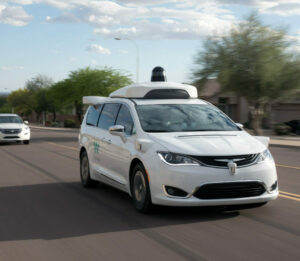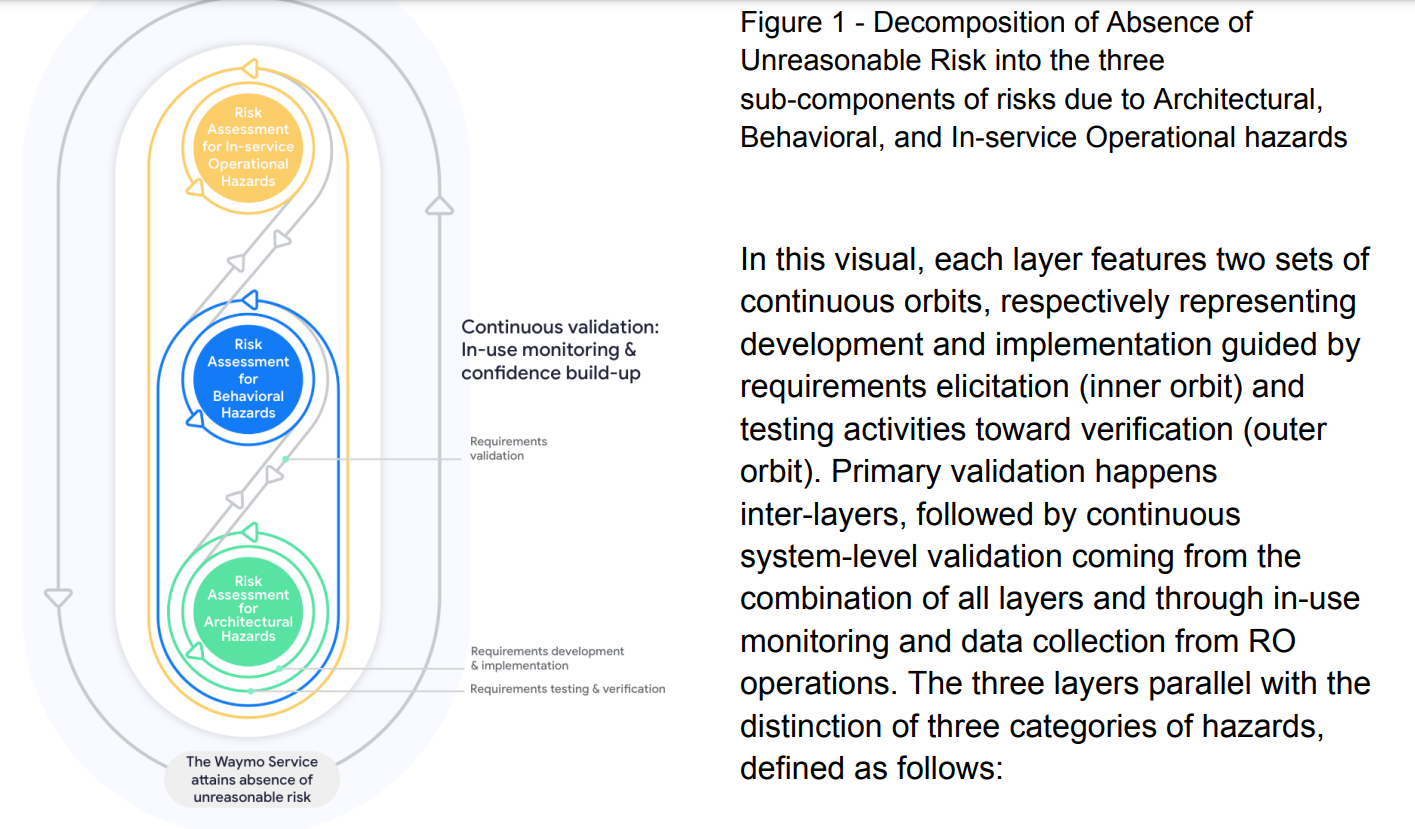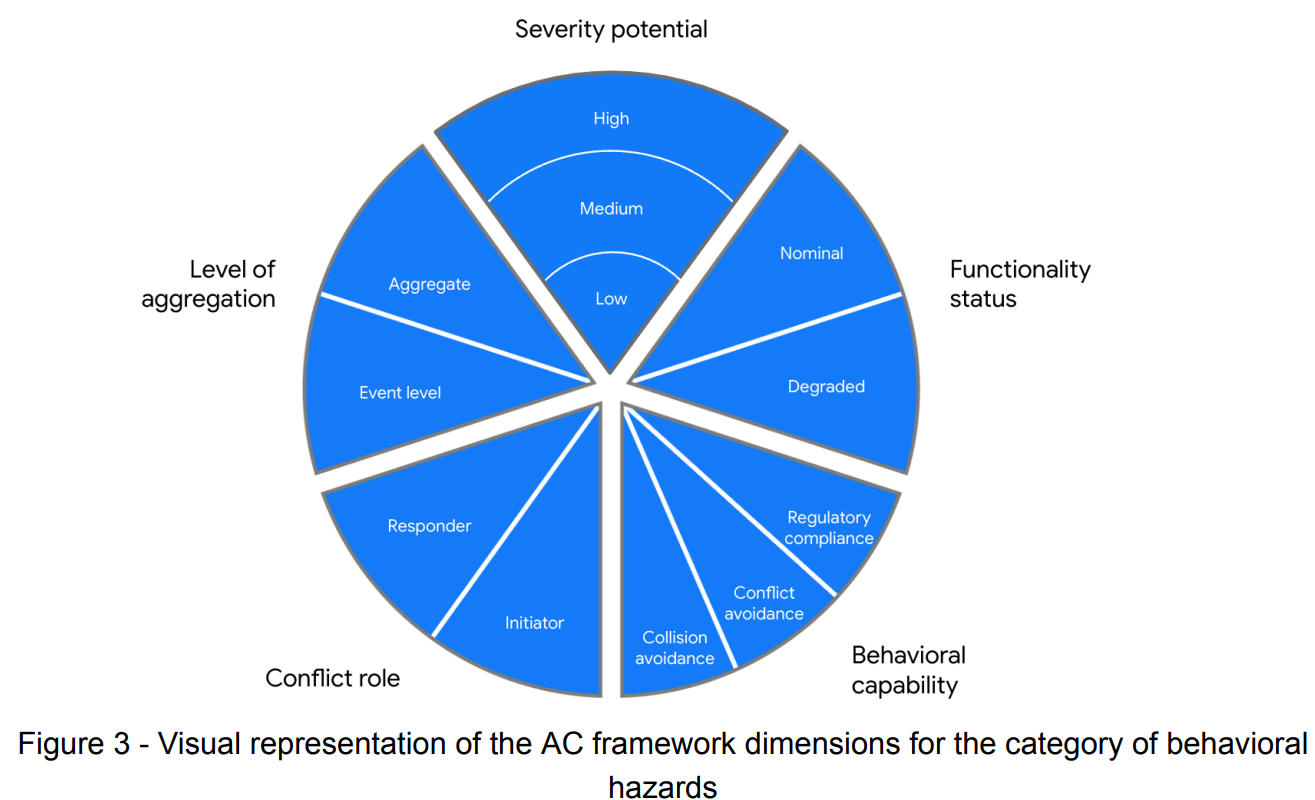
Waymo calls for transparent, credible & collaborative AV safety regulations
By onLegal | Technology
In a paper released last week on its blog, Waymo made its case for why autonomous vehicle safety regulations should be a collaborative and transparent effort between lawmakers and self-driving car companies, including “formally harmonizing” its existing safety framework “with state-of-the-art external best practices for safety cases and safety assurance.”
Currently, Waymo’s autonomous ride-hailing service, Waymo One, is offered in San Francisco, Downtown Phoenix, and East Valley. The service includes dispatching, rider support, roadside assistance, and remote assistance.
Waymo wrote their strategy and systematic approach to safety is “an important step in engendering broad trust in the credibility of the resultant safety case and will serve these purposes:
-
- “Provide transparency and foster understanding of our safety practices with safety
professionals and the general public; - “Encourage feedback on the proposed approach, and enable a dialogue on how to
concretely meet societal expectations; - “Reduce natural concerns of confirmation, outcome reporting, and publication bias.”
- “Provide transparency and foster understanding of our safety practices with safety
Waymo’s ultimate goal is to build a layered approach to rider-only driverless safety that works toward the “absence of unreasonable risk” dependent on pinpointing residual risk in specific categories of hazards across architectural, behavioral, and in-service operations, according to the paper.
“The determination of AUR rests on the explicit definition of Acceptance Criteria, which are predicated upon safety performance indicators that help to assess aspects of performance at various points on the causal chain that could result in an unreasonable risk.”
In general, Waymo summarized in its blog post that, “A safety case for fully autonomous operations is a formal way to explain how a company determines that an AV system is safe enough to be deployed on public roads without a human driver, and it includes evidence to support that determination. It involves an explanation of the system, the methodologies used to develop it, the metrics used to validate it and the actual results of validation tests. Building a case for safety requires great engineering rigor and scholarly review, which means including much more detail and context than what’s usually disclosed in AV companies’ safety reports.
“We believe the safety case-based approach can provide regulators with an unprecedented line of sight into the basis for each company’s determination that its system is ready for deployment. Yet, in order to develop a worthwhile safety case, it is first important to understand what makes one credible and well crafted, and align on evaluation criteria.”
“Regardless of the formality of any argumentation for safety of an ADS, the reality is that no system or approach will ever be considered exempt from further improvements,” Waymo states in its paper. “Rather than an indication of a stark assessment of safety guarantees, the rigor and thoughtfulness showcased in this publication are thus an expression of the principles that guide us in taking a structured and responsible approach for making our determination of safety.”
In-service operational is the third category, which Waymo defines as hazards resulting from ADS operating in a complex ecosystem that doesn’t belong to the
other two categories.
Waymo says that for each of the three hazard types, a set of explicit risk acceptance criteria needs to be stated to assess if the residual risk reached an acceptable level or needs further mitigations. For example, when behavioral hazards are assessed, Waymo considers elements that should be considered to prove whether the ADS behavior leads to unreasonable risk.
“Our experience has led us to the identification of the following five attributes as a baseline for the argumentation of absence of unreasonable risk due to behavioral hazards:
-
- “The Severity Potential: measure of the (potential) extent and scale of harmful consequences;
- “The Role Played by the ADV: either initiating a conflict or responding to one initiated by others;
- “The Type of Behavioral Capability: distinguishing between regulatory compliance, conflict avoidance, and collision avoidance capabilities;
- “The Functionality Status of the ADS: distinguishing between nominal (i.e., non-degraded) conditions and conditions in the presence of degradation;
- “The Level of Aggregation: the level at which the acceptance criterion is specified, distinguishing between acceptance criteria that enable event-level reasoning and those that only allow aggregate-level reasoning.”
Forbes Senior Contributor Brad Templeton calls out the conflict of interest in Waymo making its own case for safety since it has the most to lose and gain.
“While there are good actors and bad, we can’t inherently trust the morals of a company to act in the public interest,” he wrote. “The approach taken in the USA has been to try to nudge their motives, to align them with that interest. Most automotive systems in the USA use a system of ‘self certification.’ The regulators lay out some basic standards and goals, and the company certifies that it has done the work to comply. The company can’t be trusted on its own, but if done right the law is set up that if something bad happens, and they falsified this self-certification, they are supposed to be in for a world of hurt. This actually works fairly well if you do it right, but even so, some companies have made stupid risks in spite of this.”
But what’s the alternative? Regulator-mandated testing by third parties, according to Templeton, which also has its downsides. At the top of the list — appropriate and effective testing for the new technologies, he wrote.
Conversely, Waymo states in its paper conclusion, “The role of a safety case is to construct an argument of adequate and sufficient safety, with each claim supported by compelling evidence and explanations of why alternatives were eschewed, all in the context of a stated use-case. Safety cases exist because, when faced with new technology, consensus has to be built by understanding public expectations and connecting with regulatory development that can enable the technology and engender general trust. A number of industries have historically relied on the notion of a safety case when looking at first-of-their-kind technologies or regrettable tragedies. …Our safety framework has already guided us in deploying our service in Arizona and California, and is not a simple theoretical exercise for proof-of-concept demonstration or pilot testing.”
Lastly, Waymo states that it implements its safety cases with separate case writers and reviewers “for accuracy, efficiency, and a balance in expertise between external best practices and internal process, developing the safety case through a team led by certified safety experts, who were independent from those who developed and/or practiced Waymo’s safety framework in the first place.”
He commended Waymo for its call on the self-driving industry to be transparent with safety data and plans as well as its effort toward safety credibility.
And Templeton concluded while Waymo cars have had some mistakes, and there likely will be more, that when it comes to safety, “as long as the case is clear that this should bring us to that world of significant reduction of risk, we should try to do as little as possible to slow it down.”
In January, Waymo reached its milestone 1 million miles of public autonomous driving with no human monitor in the vehicle. The company also published detailed safety data, including descriptions of all incidents with their vehicles involved. Cruise has declined to provide similar information, though since most of their operations are in San Francisco, many of them have been reported to the California DMV, according to Forbes.
Waymo crash statistics, as reported on its blog, include:
-
- “18 minor and two major contact events in 1 million miles of operation
- “Other vehicle at fault in all vehicle-to-vehicle contacts. There were four contacts with physical objects, three of which caused no known damage
- “No reported injuries, no contacts at intersections, no contacts with vulnerable road users
- “All events were of a class unlikely to result in a severe crash or fatality, and the serious ones were front-to-rear which only account for 19% of serious crashes and 6% of fatalities in data on the general population.
- “In 55% of events, the Waymo vehicle was stopped and hit by somebody else.”
More statistical information can be found in a 30-page academic paper published by Waymo.
Other self-driving vehicle advancements
Meanwhile, Apple is making headway in continuing its AV testing in California with the latest data showing it has added more drivers, according to 9To5Mac.
“The new report shows more than 200 people authorized to support the operation of its 67-vehicle test fleet with one very minor collision happening last month,” the news site reports. “Apple’s autonomous auto testing is growing – as far as drivers – even though the latest report from Bloomberg says that the first Apple Car expected in 2026 will not come with full-self driving. But the company may still include some advanced driver assistance features that could allow drivers and passengers to ‘watch a movie or play a game’ while traveling.”
macReports writes that Apple has kept its fleet size steady at 67 after its first decrease earlier this year since July 2021.According to macReports, other notable changes include:
-
- “Mercedes has increased its number of drivers by 28.
- “Waymo cut its driving team by 52 and decreased its fleet size by 10.
- “Cruise decreased its number of drivers by 18 and made a sizable increase to its fleet size by adding 74 more vehicles.
- “Zoox has upped its driving team 1021 by adding 60 more drivers. It has added 15 cars to its fleet.
- “Nvidia increased 32.
- “Nuro dropped 29 drivers and slashed its fleet size by 71.”
Since January 13, 2023, Apple had one collision, bringing its overall total to 16. “However, even the most minor accidents have to be reported and this latest was one of those. No one was injured – it was actually just a case of curb rash when in manual mode,” 9To5Mac reports.
Waymo has had the highest number of collisions at 227 followed by Cruise at 203.
Images
Featured image: Waymo’s autonomously driven Chrysler Pacifica Hybrid minivan (Credit: Waymo)
All infographics courtesy of Waymo



